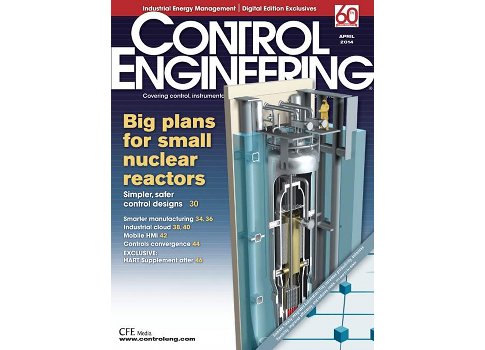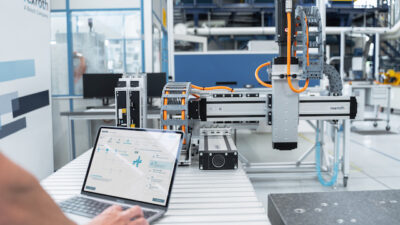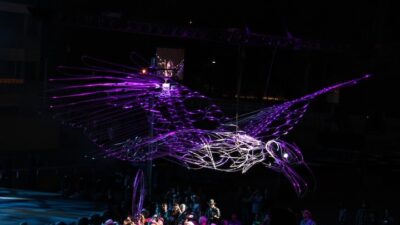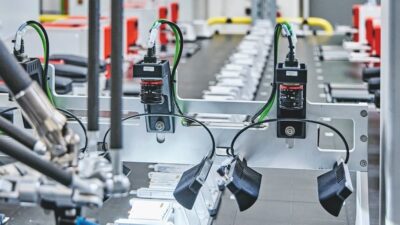Cover story: U.S. nuclear power plant outlook: new designs, safety, plant openings are part of the nuclear energy spotlight in 2014. Speakers at a recent American Nuclear Society meeting discussed more efficient nuclear reactor designs with simpler controls, nuclear plant safety, small modular reactors, and timeline for next new nuclear power plants.

More efficient nuclear power plants, small modular reactors, safety, timeline for next new nuclear power plants, and nuclear power were among topics discussed at a recent American Nuclear Society (ANS) meeting. See images and related links. Nuclear energy in the U.S. continues to progress with a mix of positive and some negative developments. An update on recent progress follows, including a summary of current issues related to the U.S. Department of Energy’s (DOE) nuclear energy programs, presented on Feb. 6 by Dr. Peter B. Lyons, DOE’s assistant secretary for nuclear energy.
The American Nuclear Society (ANS) presented Dr. Peter B. Lyons as the speaker for a February 2014 meeting of its Chicago Section. In "Current Issues: DOE’s Nuclear Energy Programs," Lyons noted that the federal Omnibus Budget (FY’14) has treated nuclear energy quite well, to the tune of $888 million. Dr. Lyons is DOE assistant secretary for nuclear energy and a former commissioner of the U.S. Nuclear Regulatory Commission (NRC).
DOE has a multitask mission to develop technologies for current and new nuclear reactors. Programs to improve reliability, sustain safety, and extend useful life apply to current reactors—while work to develop "improvements in affordability" targets new reactor technology. Other related DOE activities noted by Lyons include reducing regulatory and technology risks, managing nuclear waste, and understanding and minimizing risks of nuclear proliferation and terrorism.
Several areas of nuclear energy received substantial increases in the latest federal budget funding. One example was "advanced nuclear fuels," an initiative that plans to develop meltdown-resistant fuels, Lyons noted. Driven by the Fukushima Dai-ichi power plant incident, the accident-tolerant fuels program seeks to reduce hydrogen generation and mitigate hydrogen explosions. Only at a research and development (R&D) stage, this longer range program includes methods to improve cladding properties of fuel rods.
Advanced reactor technologies, such as high-temperature reactors, represent another area of increased funding. Current focus is on gas- and sodium-cooled reactor designs. An adjunct area is research into how to make aging nuclear power plant components last longer. It’s difficult to replace concrete structures, cables, and pressure vessels in aging plants, some of which soon will be more than 60 years old, Lyons explained.
However, the overall longevity of U.S. nuclear power plants attests to their design integrity, which has allowed license extensions and safe operation well beyond their original design life.
Thermal cycles, computational tools
Current nuclear reactors operate on the Rankine cycle, which provides about 33% thermal efficiency. Work is ongoing to develop reactors that will operate using supercritical thermodynamics based on the Brayton cycle, allowing greater than 40% efficiency. Lyons also mentioned dramatic turbine size reduction and more efficient thermal conversion obtainable with Brayton cycle power plants.
High-performance computing and advanced modeling and simulation play a crucial role in managing the complex physics and control requirements of nuclear energy. A number of further initiatives are being pursued to advance existing and new reactor designs. New computational tools will allow researchers to focus on details not previously practicable. This is seen as enabling solutions applicable to wide areas ranging from nuclear fuels to the operation of complete nuclear power plants, according to DOE.
SMR technologies
Small modular reactors (SMRs)—typically under 300 megawatt electric (MWe) output-represent a relatively new approach for nuclear energy. Industry experts consider such smaller reactor designs as a key element for the resurgence of U.S. nuclear energy. Lyons listed several benefits of SMRs.
— Factory-built SMR units can be transported intact to the plant site. As a result, associated capital costs can be lower and small reactors could be a more economically feasible investment for more power companies.
— Modularity means reactors can be brought online in "bite-sized" chunks-as determined by power demand. SMRs also pose potentially less strain on the electric grid.
— Small modular reactors offer further attributes to the market. For example, they could more easily live up to construction schedules, fit well into smaller electricity grids of many countries, and can be air cooled, according to Lyons.
"Overall, small modular reactors could represent a new paradigm for nuclear energy," Lyons said. "Cost per kilowatt will be key."
DOE has entered into cost sharing agreements with industry to develop SMRs. Two recent programs are noteworthy. One agreement, awarded to mPower America—a partnership of Babcock & Wilcox Co., Tennessee Valley Authority (TVA), and Bechtel—has the goal to support commercial operation of a 180-MWe reactor by 2022 to be built at TVA’s Clinch River site in Oak Ridge, Tenn. Lyons mentioned that mPower’s reactor design is based on 60-year life and a 4-year refueling cycle. The rail-shippable integral pressurized water reactor modules will feature passive safety systems.
Commercial operation in 2021
mPower America has developed a plan that expects to achieve a commercial operation date of October 2021, according to DOE. Key program activities include:
- Submitting design certification application to the NRC by late 2014 for approval by 2018.
- Performing geological characterization at TVA’s Clinch River site.
- Submitting a construction permit application to the NRC by mid-2015 for approval by 2018.
A second SMR initiative announced in December 2013 was with NuScale Power LLC. It’s described by DOE as offering a mix of safety, scalability, transportability, economics, and advanced state of design maturity. This cooperative agreement with DOE is forecast to achieve commercial operation in the 2025 timeframe. NuScale Power’s reactor design intends to implement smaller 45 MWe modules that feature natural circulation (gravity, convection, and conduction) for normal operations and safe shutdown-without the need for pumps, Lyons noted. The integral pressurized water reactor design allows scalability for up to 12 modules at one plant site with maximum 540 MWe output.
Key activities include:
- Complete the preliminary design by the first quarter of 2015
- Execute testing programs in support of design development and NRC review requirements
- Submit design certification application to the NRC by mid-2015 for approval by late 2018
- Complete primary system final design by the end of 2018.
Nuclear energy has its opponents, whether those reactors are of traditional utility scale or small and modular. SMR opponents pose arguments of distributing nuclear facilities to more sites and associated potential for terrorism. The counterpoint is the exceptional safety record of larger U.S. nuclear reactors, sometimes referred to as the "platinum standard." Safety can be expected to be further leveraged into future small modular reactor designs.
Control aspects of small modular reactors
Reduced physical size allows implementing simpler instrumentation and control (I&C) systems for small modular reactors (SMRs) compared to large light-water reactors. Simplicity includes use of natural circulation through the reactor—eliminating the need for pumps in some designs—as is the case for NuScale Power’s development. Reactor safety remains the paramount consideration.
SMR plant I&C architecture is composed of two main system types: one for safety-related functions and one for non-safety-related functions. Safety-related I&C architecture will be a new hardware logic based system, incorporating multiple layers of diversity to enable simplicity of the overall plant protection system architecture, according to NuScale Power. Choice of the non-safety I&C system platform will be left to a site license applicant and will not be specified for design certification.
I&C system functions and process variables to be monitored will be similar to those for a typical pressurized water reactor—for example, pressure, temperature, flow, level, and neutron flux. Number of sensors per reactor module is yet to be determined, but will be proportionally less than the number for a typical large light-water reactor, NuScale noted.
As for I&C system communications and/or bus networks, a custom and proprietary design will be used for safety-related functions; for non-safety-related functions this area will not be specified for SMR design certification.
State of the industry
The good news is that five new nuclear power units are presently under construction after a 30-plus-year hiatus (see reference online). New construction comprises two reactors at the A.W. Vogtle power plant (units 3 and 4) in Georgia, being built by Southern Co., and two reactors under construction at South Carolina Electric & Gas Co.’s V.C. Summer plant (units 2 and 3) located in that state. An additional, partially built reactor is being completed at TVA’s Watts Bar unit 2 plant in Tenn.
Expected operating dates for these new reactors are presently on the following schedule: Watts Bar 2 by late 2015; Vogtle 3 and 4 in 2017 and 2018, respectively; and Summer 2 and 3 in late 2017 and 2019, respectively. Over a longer time frame (2022-2025) another four to six reactors may come online.
Meanwhile, five reactors have been shut down recently due to various reasons other than safety problems. Flat electricity demand and low natural gas prices, along with age-related issues are the forces that could cause further reactor shutdowns. One example of the above market forces leading to an early closing is the case of Dominion’s Kewaunee (Wis.) plant. This otherwise well-performing nuclear plant with many years of scheduled operation remaining was closed in 2013. As the DOE’s Lyons puts it, the U.S. market situation is such that "The nation doesn’t currently value nuclear energy."
The U.S. still has the largest number of nuclear reactors operating (99 as of this writing), but as a result of recent closings, nationwide electric power generation from nuclear sources has dropped to 18%-down from just above 20% where it stood over a substantial time period. Although 18% of total U.S. electricity production represents a huge energy resource, it does indicate a serious trend.
"Impact of nuclear energy plant retirements could have a dramatic future effect on power availability," Lyons said. One possible scenario being reviewed by DOE is the potential closure of one-third of the U.S. reactors by 2035 due to end of design life. Without sufficient replacements, such a development would pose serious concerns.
In comparison, 70 nuclear units are under construction worldwide, with China, South Korea, and Russia among prominent participants.
Some people have referred to the recent new plant construction in the U.S. as a nuclear renaissance. "I don’t call it a nuclear energy renaissance," Lyons concluded. "The nation will need far more nuclear power in the future for which we have to be ready."
The American Nuclear Society is a not-for-profit, international, scientific and educational organization headquartered in Washington, D.C. The core purpose of ANS is to promote awareness and understanding of the application of nuclear science and technology.
– Frank J. Bartos, P.E., is a Control Engineering contributing content specialist. Reach him at [email protected].
ONLINE
Key concepts
- U.S. Department of Energy has a mission to develop technologies for current and new nuclear reactors.
- New technologies aim at improving efficiencies and safety.
- Five nuclear power reactors are under construction in the U.S.
Consider this
Without expansion of U.S. nuclear development, a baseload power shortage seems likely as the last-generation of power plants retire.
– See related articles at the bottom of this posting.
Advancing Technology: ‘American Idle’ – Nuclear Power
Reference – U.S. nuclear power update: A 2012 overture?



